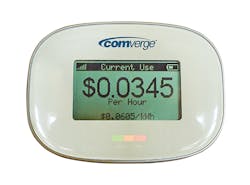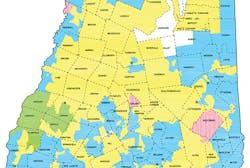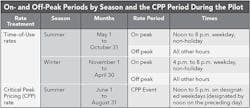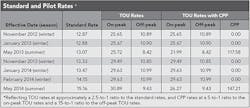NHEC Initiates Dynamic Pricing
Over the course of two years, New Hampshire Electric Cooperative (NHEC) conducted a broad-based evaluation of the capability of dynamic pricing to shift load away from peak hours and conserve energy. The capability of certain technologies to support the logistics of the pilot was also tested.
The utility is currently considering takeaways from the pilot program, along with a parallel study of its direct load control program, to plan its overall future demand-response strategy. Dynamic pricing mechanisms can more accurately pass along power and transmission costs as well as affect customer energy-consumption behavior, all while enabling the utility to maintain a high degree of customer satisfaction.
Setting the Stage
NHEC requested and received a smart grid investment grant from the U.S. Department of Energy for the modernization of communications systems infrastructure and installation of advanced metering infrastructure for its members. As part of the grant request, the co-op committed to conducting a voluntary pilot program on dynamic pricing for its residential customers over a two-year period.
NHEC resolved to use pilot participant load data not only to discern the impact of the pilot on participant behavior and loads, but also to evaluate the performance of enabling technologies and systems to determine whether to continue, modify or terminate the program. The pilot commenced in November 2012 and continued through October 2014.
Leidos Engineering worked with NHEC on strategy formulation, rate design, a review of certain technologies and various statistical analyses, including participant load data. Separately, Leidos assisted NHEC with a review of its direct load control system and the formulation of upgrade strategies.
During the course of a two-day strategy session and a review of NHEC’s power supply situation, the project team determined the pilot would incorporate both differentiated pricing based on time of day — capturing primarily energy cost differences, or time-of-use (TOU) pricing — and differentiated pricing during certain hours on potential peak days — capturing the majority of capacity costs, or critical peak pricing (CPP).
Finally, an added element was the evaluation of Comverge in-home displays (IHD), which provide information on the current electricity price, impending CPP events and current consumption, and their influence on energy consumption.
Soliciting Participants and Design
NHEC solicited participants from approximately 5,700 residential customers located in a central portion of its service area, netting 564 volunteers — a rate of nearly 10%. Customer volunteers were placed randomly into four groups, three participant groups and one control group:
- A TOU group received an IHD and was subjected to TOU pricing only
- A TOUCPP group received an IHD and was subjected to both TOU pricing and CPP
- An IHD-only group received an IHD only, with no change in electric rates
- A control group was thanked for volunteering but told they were not selected as part of the pilot based on the random process and remained on NHEC’s standard rate.
The IHD-only group was intended to allow the utility to test whether real-time information about electric usage would encourage conservation, even without any direct economic incentive to conserve relative to the average consumer. The control group enabled a comparison to the other groups without the results being impacted by the differing habits and inclinations of the rest of the customer base who were not volunteers, a potential problem in behavioral studies referred to as “self-selection bias.”
Determining Rates
Based on an examination of NHEC’s power supply and transmission cost drivers, on- and off-peak periods by season and a CPP event period were set for purposes of developing pilot rates.
To develop pilot rates that were cost based and revenue neutral to the typical residential customer, marginal costs across various power supply and transmission cost categories were determined on an hourly average basis (that is, dollars per kilowatt-hour) and applied to a prototype residential customer profile. Average costs were then determined for each of the TOU rate periods in question.
However, for purposes of the CPP rate, the average cost associated with the forward capacity market (FCM) of the Independent System Operator for New England (ISO-NE) was removed from the costs applied to the prototype profile and distributed solely over the CPP period. For the pilot, the utility assumed six CPP events would be called over the summer, resulting in a CPP rate that captured both the FCM costs and higher energy costs associated with other power supply and transmission cost differentials.
Analyzing Behavior with Load Profiles
During the course of the pilot, the co-op’s staff compiled hourly load data for the participant and control group customers and developed a database of load data, pilot rate period load averages, customer-specific appliance information, day-type identifiers and weather data. NHEC staff also benchmarked the hourly load data to independent, rate-period-specific consumption data stored and transmitted by the meters (that is, register reads) for billing purposes to verify accuracy. The resulting data was imported into statistical analysis software to be analyzed in an iterative fashion using an econometric approach to ascertain whether, and to what extent, load patterns were impacted by the pilot for each participant group.
The analysis yielded several noteworthy observations. TOU and TOUCPP participants’ consumption during CPP events tended to be lower than during other days for those customers and that of the control group by approximately 0.25 kWh and 0.91 kWh, respectively. Similarly, the load of TOU and TOUCPP participants during the ISO-NE peak hour tended to be lower than on other days and lower than the load of the control group by approximately 0.07 kW and 0.26 kW, respectively.
Summer on-peak consumption for TOU and TOUCPP participants (that is, during the eight-hour on-peak period) tended to be less than the control group by approximately 0.19 kWh and 0.51 kWh, respectively. In addition, no differences in overall daily consumption were discernible, which indicates the energy abatement was isolated to the on-peak period.
No difference in consumption for the IHD-only group could be discerned subsequent to the start of the pilot period and relative to the control group. Accordingly, this analysis shows the IHD did not have a statistically significant impact on energy consumption.
For both the TOU group and the TOUCPP group, the majority of participants had positive savings. The impact of the pilot on participant electricity costs ranged from a 9.3% reduction, or savings, to a 10.7% increase for TOU participants relative to the regular, or standard, rate. For the TOUCPP participants, the impact ranged from a 10.4% reduction, or savings, to a 6.3% increase, or loss, relative to the regular rate.
Based on more detailed analysis of the participants with the highest savings and loss, it was clear consumption behavior was the driver of the outcome of the bill comparisons. Those with the largest bill decrease in the TOU and TOUCPP groups consumed the least energy during the on-peak periods and CPP events relative to their overall consumption. TOU and TOUCPP participants who consumed significantly more energy during on-peak periods and the critical peak events relative to their overall consumption paid significantly more for their energy.
Customer Reaction
During the course of the pilot, two surveys were conducted, the first in December 2013 and the second in November 2014. The surveys were intended to uncover participant demographic information, perceptions regarding the pilot, actions being taking in response to the pilot, and participant satisfaction with the pilot and NHEC staff. The response rates to both surveys were just under 50%.
The majority of respondents, 71% to 88% across the two surveys, reported their efforts to conserve during the pilot ranged from being worthwhile to very worthwhile. The majority of respondents, 82%, also reported being somewhat satisfied to very satisfied with their interactions with NHEC staff during the pilot.
IHDs performed reasonably well, despite issues with battery life, and more than two-thirds of respondents reported looking at the IHDs at least once per week. However, customers used e-mails from NHEC more often for pricing information than the IHD.
Approximately 50% of those in TOU and TOUCPP groups reported they would be very likely to participate in a TOU rate plan similar to the pilot in the future.
The Future
NHEC’s pricing pilot demonstrated the effectiveness of TOU rates in impacting participants’ behavior while maintaining a high level of customer satisfaction and not overwhelming co-op staff and systems with the additional required data analysis to produce accurate bills and manage large data sets.
The varied performance of communications technology during the early part of the pilot highlighted the need to phase in technologies rather than requiring every piece to work seamlessly together from day one. The value of IHDs as a primary means to communicate pricing changes and consumption was questioned given the other communications avenues available to NHEC through other technologies (for example, smartphones and the Internet) already in common use by participants.
NHEC’s pilot was a success and is anticipated to guide its future plans regarding demand-response efforts in concert with other programs. Dynamic pricing proved to be a useful means to reflect the cost of power and transmission more accurately in rates to which customers actually paid and reacted. A balance between the accuracy of this transfer of costs to the customer and simplicity of the rate structure was an important element of the pilot’s success.
Heather Manypenny ([email protected]) has been employed by New Hampshire Electric Cooperative for 24 years. She is the power resources executive, part of a team responsible for contracting for power and renewable attributes, interaction and compliance with the Independent System Operator for New England, demand-response and revenue requirements for power supply and transmission. Manypenny co-led the team responsible for implementation and study of the dynamic pricing element of NHEC’s smart grid deployment.
Jonathan Nunes ([email protected]) is an economist at Leidos Engineering with more than 20 years of experience in power supply planning, financial planning and analysis, and economic modeling for utilities and regulatory agencies. He has conducted numerous demand-response and load analytics studies. He also has presented the findings of studies he has led before a number boards of directors and industry groups.







